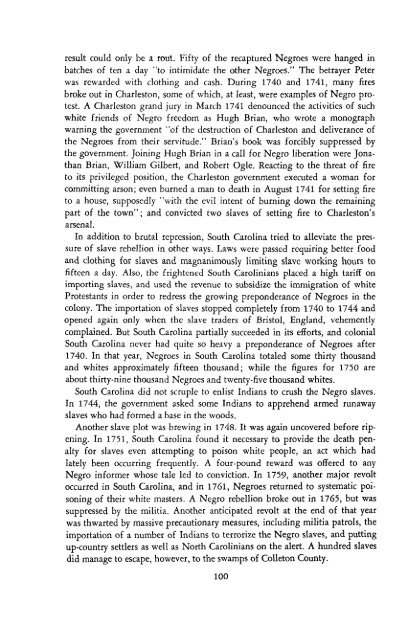Conceived in Liberty Volume 2 - Ludwig von Mises Institute
Conceived in Liberty Volume 2 - Ludwig von Mises Institute
Conceived in Liberty Volume 2 - Ludwig von Mises Institute
You also want an ePaper? Increase the reach of your titles
YUMPU automatically turns print PDFs into web optimized ePapers that Google loves.
esult could only be a rout. Fifty of the recaptured Negroes were hanged <strong>in</strong><br />
batches of ten a day "to <strong>in</strong>timidate the other Negroes." The betrayer Peter<br />
was rewarded with cloth<strong>in</strong>g and cash. Dur<strong>in</strong>g 1740 and 1741, many fires<br />
broke out <strong>in</strong> Charleston, some of which, at least, were examples of Negro protest.<br />
A Charleston grand jury <strong>in</strong> March 1741 denounced the activities of such<br />
white friends of Negro freedom as Hugh Brian, who wrote a monograph<br />
warn<strong>in</strong>g the government "of the destruction of Charleston and deliverance of<br />
the Negroes from their servitude." Brian's book was forcibly suppressed by<br />
the government. Jo<strong>in</strong><strong>in</strong>g Hugh Brian <strong>in</strong> a call for Negro liberation were Jonathan<br />
Brian, William Gilbert, and Robert Ogle. React<strong>in</strong>g to the threat of fire<br />
to its privileged position, the Charleston government executed a woman for<br />
committ<strong>in</strong>g arson; even burned a man to death <strong>in</strong> August 1741 for sett<strong>in</strong>g fire<br />
to a house, supposedly "with the evil <strong>in</strong>tent of burn<strong>in</strong>g down the rema<strong>in</strong><strong>in</strong>g<br />
part of the town"; and convicted two slaves of sett<strong>in</strong>g fire to Charleston's<br />
arsenal.<br />
In addition to brutal repression, South Carol<strong>in</strong>a tried to alleviate the pressure<br />
of slave rebellion <strong>in</strong> other ways. Laws were passed requir<strong>in</strong>g better food<br />
and cloth<strong>in</strong>g for slaves and magnanimously limit<strong>in</strong>g slave work<strong>in</strong>g hours to<br />
fifteen a day. Also, the frightened South Carol<strong>in</strong>ians placed a high tariff on<br />
import<strong>in</strong>g slaves, and used the revenue to subsidize the immigration of white<br />
Protestants <strong>in</strong> order to redress the grow<strong>in</strong>g preponderance of Negroes <strong>in</strong> the<br />
colony. The importation of slaves stopped completely from 1740 to 1744 and<br />
opened aga<strong>in</strong> only when the slave traders of Bristol, England, vehemently<br />
compla<strong>in</strong>ed. But South Carol<strong>in</strong>a partially succeeded <strong>in</strong> its efforts, and colonial<br />
South Carol<strong>in</strong>a never had quite so heavy a preponderance of Negroes after<br />
1740. In that year, Negroes <strong>in</strong> South Carol<strong>in</strong>a totaled some thirty thousand<br />
and whites approximately fifteen thousand; while the figures for 1750 are<br />
about thirty-n<strong>in</strong>e thousand Negroes and twenty-five thousand whites.<br />
South Carol<strong>in</strong>a did not scruple to enlist Indians to crush the Negro slaves.<br />
In 1744, the government asked some Indians to apprehend armed runaway<br />
slaves who had formed a base <strong>in</strong> the woods.<br />
Another slave plot was brew<strong>in</strong>g <strong>in</strong> 1748. It was aga<strong>in</strong> uncovered before ripen<strong>in</strong>g.<br />
In 1751, South Carol<strong>in</strong>a found it necessary to provide the death penalty<br />
for slaves even attempt<strong>in</strong>g to poison white people, an act which had<br />
lately been occurr<strong>in</strong>g frequently. A four-pound reward was offered to any<br />
Negro <strong>in</strong>former whose tale led to conviction. In 1759, another major revolt<br />
occurred <strong>in</strong> South Carol<strong>in</strong>a, and <strong>in</strong> 1761, Negroes returned to systematic poison<strong>in</strong>g<br />
of their white masters. A Negro rebellion broke out <strong>in</strong> 1765, but was<br />
suppressed by the militia. Another anticipated revolt at the end of that year<br />
was thwarted by massive precautionary measures, <strong>in</strong>clud<strong>in</strong>g militia patrols, the<br />
importation of a number of Indians to terrorize the Negro slaves, and putt<strong>in</strong>g<br />
up-country settlers as well as North Carol<strong>in</strong>ians on the alert. A hundred slaves<br />
did manage to escape, however, to the swamps of Colleton County.<br />
100
















